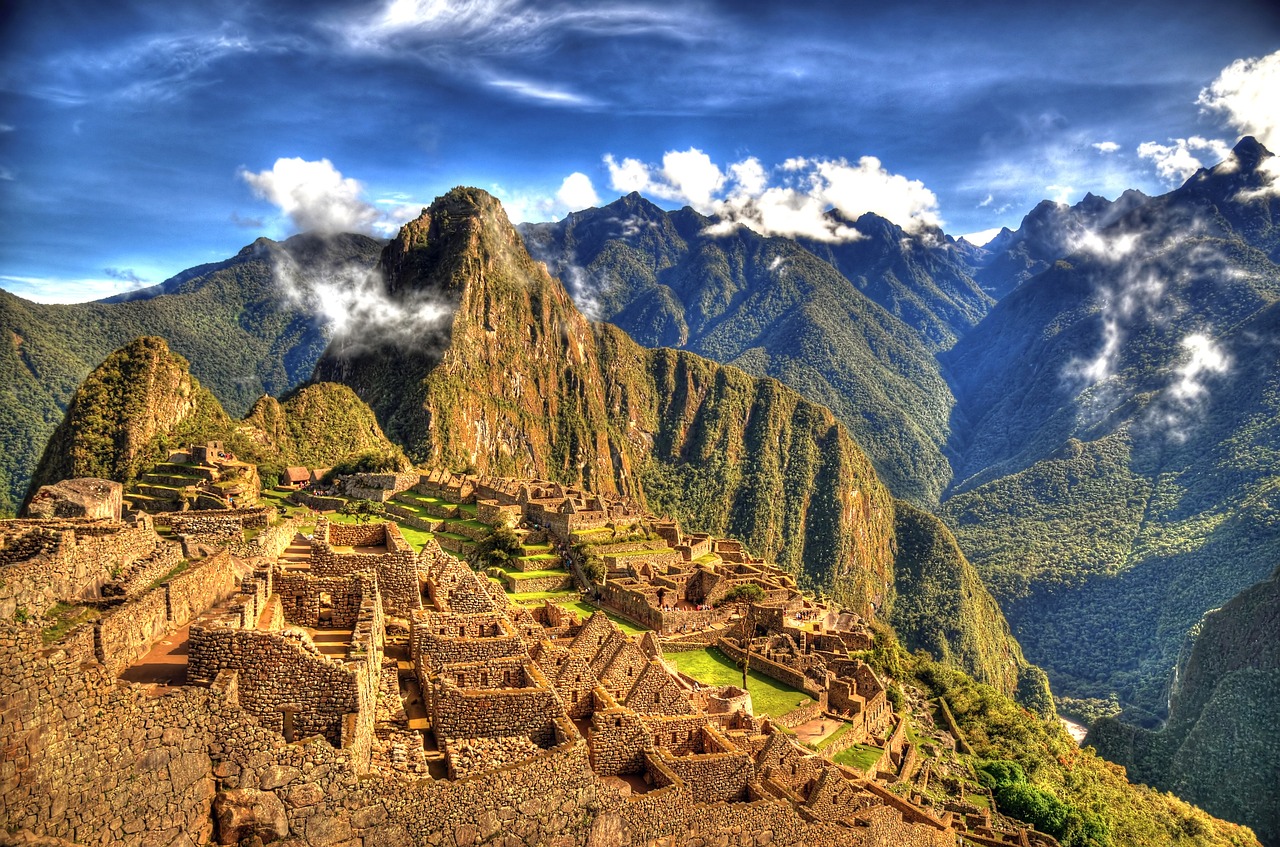The Secrets of Ancient Societies' Communication
Have you ever wondered how ancient civilizations communicated and interacted with each other without the modern technologies we have today? The secrets of ancient societies' communication unveil a world of fascinating methods and tools that were used to connect communities and convey messages across vast distances.
One of the most intriguing forms of communication in ancient times was through cave paintings and petroglyphs. These visual representations on cave walls and rocks served as a means to convey messages, tell stories, and share important information within prehistoric societies. Imagine the stories these ancient drawings could tell, capturing moments in time for future generations to decipher.
Delving deeper into the mysteries of ancient communication, hieroglyphics and pictograms played a crucial role in civilizations like ancient Egypt. These intricate symbols were not only used for communication but also for record-keeping, providing valuable insights into the daily lives and beliefs of past societies. Deciphering these ancient writings is like unlocking a time capsule of knowledge and wisdom.
Imagine a time when smoke signals and beacon fires were the high-tech communication tools of their era. Various ancient cultures utilized these methods to send messages across long distances, showcasing the ingenuity and resourcefulness of our ancestors. The sight of smoke rising or a beacon fire glowing in the distance would have sparked excitement and anticipation, signaling the arrival of important news or warnings.
Carrier pigeons and messenger birds were the feathered couriers of ancient times, carrying messages swiftly and reliably across vast distances. The practice of using these birds as messengers highlights the clever ways in which ancient societies harnessed the natural world for their communication needs. The sight of a pigeon soaring through the sky with a vital message attached to its leg must have been a sight to behold.
The Incan quipu system, with its intricate knotted cords, served as a unique method of recording numerical and narrative information in ancient South American societies. These knotted cords were not just for show but held valuable data that helped in communication and data storage. Each knot telling a story, each cord holding a secret waiting to be unraveled.
Drum codes and signal horns resonated through ancient civilizations, conveying messages through rhythmic beats and distinctive sounds. The use of auditory forms of communication added a new dimension to how information was shared, creating a symphony of signals that echoed across vast lands. The beat of a drum or the blast of a horn could carry news, warnings, or celebrations from one community to another.
The significance of runic alphabets and Ogham script in ancient communication practices cannot be understated. These symbolic writing systems played a vital role in conveying messages in early societies, laying the foundation for written communication as we know it today. Each symbol carrying meaning, each script telling a tale of a bygone era.
Exploring the interconnectedness of ancient societies through trade routes like the Silk Road reveals not only the exchange of goods but also the flow of information and cultural communication. These pathways served as conduits for not just commerce but also the sharing of ideas, beliefs, and innovations. The Silk Road was more than a trade route; it was a highway of knowledge and cultural exchange.

Cave Paintings and Petroglyphs
Exploring the fascinating methods and tools used by ancient civilizations to communicate and interact with one another, shedding light on the intricate networks and systems that facilitated connections in the past.
Before the written word, ancient societies found ingenious ways to communicate through visual mediums. Cave paintings and petroglyphs, dating back thousands of years, served as the canvas for these early messages. Imagine standing in a dimly lit cave, surrounded by vibrant paintings depicting hunting scenes, rituals, and daily life. These intricate artworks were not just decorations but a form of communication, telling stories and passing down knowledge from one generation to the next.
The use of symbols and images on cave walls allowed prehistoric communities to convey important information without the need for written language. From the majestic Lascaux caves in France to the mysterious petroglyphs of the American Southwest, these ancient artworks provide a window into the past, offering insights into the beliefs, practices, and daily lives of our ancestors.
Through these visual representations, ancient societies were able to communicate complex ideas, share cultural traditions, and preserve their history for future generations. The intricate details and symbolism found in cave paintings and petroglyphs speak volumes about the creativity and ingenuity of our early ancestors, showcasing their ability to communicate through art long before the advent of modern writing systems.

Hieroglyphics and Pictograms
Exploring the fascinating methods and tools used by ancient civilizations to communicate and interact with one another, shedding light on the intricate networks and systems that facilitated connections in the past.
Discovering how prehistoric societies utilized visual representations on cave walls and rocks to convey messages, tell stories, and communicate important information within their communities.
Unraveling the mysteries of ancient Egyptian hieroglyphics and other pictorial writing systems, exploring how these intricate symbols were used for communication and record-keeping in societies of the past.
Ancient civilizations, such as the Egyptians, developed complex systems of hieroglyphics and pictograms to communicate through visual symbols. These intricate characters were not only used for writing but also for artistic expression and storytelling. Imagine the awe-inspiring temples and tombs adorned with these mysterious symbols, each carrying a unique message waiting to be deciphered.
The hieroglyphics were a blend of pictorial representations and abstract symbols, creating a rich tapestry of communication that captured the essence of ancient Egyptian culture and history. From monumental inscriptions on temple walls to detailed records on papyrus scrolls, hieroglyphics played a crucial role in preserving the knowledge and wisdom of the past.
Similarly, pictograms, which are simplified visual symbols representing objects or concepts, were used by various ancient societies to convey information quickly and effectively. These pictorial representations transcended language barriers, allowing for communication across diverse cultures and languages.
Unlocking the secrets of hieroglyphics and pictograms unveils a world where art, language, and history intersect, offering a glimpse into the sophisticated communication methods of ancient civilizations.
1. What were the main purposes of hieroglyphics in ancient Egypt?
2. How did ancient societies use pictograms for communication?
3. Were hieroglyphics reserved only for the elite in ancient civilizations?
4. What role did pictograms play in cross-cultural communication?
5. How were hieroglyphics deciphered by modern scholars?

Smoke Signals and Beacon Fires
Smoke signals and beacon fires were ingenious methods employed by ancient civilizations for long-distance communication. Imagine standing on a hill, watching as a plume of smoke rises in the distance, carrying a message from afar. These signals were not just random puffs of smoke; they were carefully crafted codes that could convey a variety of messages, from warnings of danger to calls for assistance.
Ancient cultures, such as the Native American tribes and the Chinese, utilized smoke signals to communicate across vast distances. By creating different patterns and durations of smoke, they could transmit specific messages without the need for spoken words. It was a visual language that transcended barriers of distance and terrain, allowing for swift and effective communication in times of need.
Similarly, beacon fires were used as signals of communication in various ancient societies. Picture a series of fires being lit on hilltops or towers, creating a chain reaction of light that could be seen for miles around. These beacon fires served as a form of early warning system, alerting neighboring communities to potential threats or important events.
By strategically placing these beacon fires along key points of communication, ancient civilizations could relay messages swiftly and efficiently, much like a relay race where the baton was a flickering flame. The sight of these beacon fires burning brightly against the night sky must have been a powerful symbol of unity and connection among distant peoples.

Carrier Pigeons and Messenger Birds
Exploring the fascinating methods and tools used by ancient civilizations to communicate and interact with one another, shedding light on the intricate networks and systems that facilitated connections in the past.
Discovering how prehistoric societies utilized visual representations on cave walls and rocks to convey messages, tell stories, and communicate important information within their communities.
Unraveling the mysteries of ancient Egyptian hieroglyphics and other pictorial writing systems, exploring how these intricate symbols were used for communication and record-keeping in societies of the past.
Examining the use of smoke signals and beacon fires as long-distance communication methods by various ancient cultures, highlighting their effectiveness in conveying messages across vast distances.
Delving into the historical practice of using carrier pigeons and other birds as messengers in ancient societies, showcasing the ingenuity behind utilizing these feathered creatures for communication.
Exploring the unique Incan quipu system of knotted cords used for recording numerical and narrative information, shedding light on this ancient method of communication and data storage.
Investigating the use of drum codes and signal horns by ancient civilizations as auditory forms of communication, examining how rhythmic beats and distinctive sounds were employed to convey messages.
Uncovering the significance of runic alphabets and Ogham script in ancient communication practices, tracing the origins of these symbolic writing systems and their role in conveying messages in early societies.
Exploring the interconnectedness of ancient societies through trade routes like the Silk Road, highlighting how these pathways facilitated not only the exchange of goods but also the flow of information and cultural communication.

Incan Quipu System
Exploring the fascinating methods and tools used by ancient civilizations to communicate and interact with one another, shedding light on the intricate networks and systems that facilitated connections in the past.
The Incan Quipu System was a remarkable method of communication and data storage utilized by the ancient Incas. This system involved the use of knotted cords made from different colored strings, each with a specific meaning or numerical value. The intricate patterns of knots and cords allowed the Incas to record information ranging from numerical data to narrative accounts.
Each quipu was unique and served as a form of writing and record-keeping for the Incan civilization. The cords were often arranged in various combinations, and the position of knots and colors conveyed specific messages. This ingenious method enabled the Incas to communicate complex information without the need for a written language.
Furthermore, the Incan Quipu System was not only used for communication but also played a crucial role in administrative and organizational tasks within the empire. It served as a means of recording census data, tracking goods and resources, and even documenting historical events.
The quipu's versatility and efficiency in conveying information highlight the ingenuity of ancient societies in developing unique communication systems tailored to their specific needs. The Incan Quipu System stands as a testament to the advanced level of organization and communication achieved by the Incan civilization.

Drum Codes and Signal Horns
Exploring the fascinating methods and tools used by ancient civilizations to communicate and interact with one another, shedding light on the intricate networks and systems that facilitated connections in the past.
Discovering how prehistoric societies utilized visual representations on cave walls and rocks to convey messages, tell stories, and communicate important information within their communities.
Unraveling the mysteries of ancient Egyptian hieroglyphics and other pictorial writing systems, exploring how these intricate symbols were used for communication and record-keeping in societies of the past.
Examining the use of smoke signals and beacon fires as long-distance communication methods by various ancient cultures, highlighting their effectiveness in conveying messages across vast distances.
Delving into the historical practice of using carrier pigeons and other birds as messengers in ancient societies, showcasing the ingenuity behind utilizing these feathered creatures for communication.
Exploring the unique Incan quipu system of knotted cords used for recording numerical and narrative information, shedding light on this ancient method of communication and data storage.
Investigating the use of drum codes and signal horns by ancient civilizations as auditory forms of communication, examining how rhythmic beats and distinctive sounds were employed to convey messages.
Uncovering the significance of runic alphabets and Ogham script in ancient communication practices, tracing the origins of these symbolic writing systems and their role in conveying messages in early societies.
Exploring the interconnectedness of ancient societies through trade routes like the Silk Road, highlighting how these pathways facilitated not only the exchange of goods but also the flow of information and cultural communication.
Stay tuned for the frequently asked questions section coming soon!

Runes and Ogham Script
Exploring the fascinating methods and tools used by ancient civilizations to communicate and interact with one another, shedding light on the intricate networks and systems that facilitated connections in the past.
Runes and Ogham script hold a mystical allure, serving as ancient languages that transcended mere words. Runes, with their angular shapes and symbolic meanings, were used by various early Germanic tribes for communication and magical inscriptions. The Ogham script, on the other hand, employed a series of lines and notches carved into stone or wood, originating in ancient Ireland and serving as a form of written communication. Both systems carried profound cultural significance, embodying the essence of communication beyond mere words.

Trade Routes and Silk Road
The Silk Road, an ancient network of trade routes spanning from China to the Mediterranean, was a bustling thoroughfare of goods, ideas, and culture. Picture a vast web of interconnected pathways, like threads weaving through the fabric of civilizations. Merchants traversed deserts, mountains, and seas, carrying silk, spices, precious metals, and exotic goods. Along with these tangible commodities, intangible treasures of knowledge, beliefs, and customs flowed freely, fostering cross-cultural exchanges and shaping the development of societies along the route.
At the heart of the Silk Road's significance lay its role as a conduit for communication. As caravans journeyed through distant lands, they became bearers of not just merchandise but also information. Imagine the exchange of languages, stories, and innovations taking place at bustling marketplaces and caravanserais. The Silk Road was more than a trade route; it was a bridge that connected diverse peoples and enabled the transmission of ideas across vast distances.
The Silk Road was not a single path but a complex network of interconnected routes. Just like branches of a tree reaching out in different directions, the Silk Road branched into northern, southern, and maritime routes, each facilitating distinct exchanges and interactions. This intricate web of connections crisscrossed continents, linking the East and the West in a tapestry of commerce and cultural interchange.
Through the Silk Road, technologies, philosophies, and artistic styles traveled far and wide, transcending borders and enriching the tapestry of human civilization. It was a highway of innovation, where inventions like papermaking, printing, and gunpowder spread like wildfire, transforming societies and shaping the course of history. The Silk Road was not merely a physical route but a lifeline of communication that nurtured a global exchange of ideas and experiences.
Frequently Asked Questions
- What were the primary forms of communication used by ancient societies?
Ancient societies utilized a variety of communication methods, including cave paintings, hieroglyphics, smoke signals, carrier pigeons, drum codes, runes, and trade routes.
- How did ancient civilizations convey messages over long distances?
Ancient civilizations used innovative techniques such as smoke signals, beacon fires, and messenger birds like carrier pigeons to communicate across vast distances effectively.
- What was the significance of the Incan quipu system?
The Incan quipu system was a unique method of communication using knotted cords for recording numerical and narrative information, showcasing the advanced communication techniques of the Inca civilization.
- How did ancient societies maintain cultural connections through trade routes?
Ancient societies maintained cultural connections through trade routes like the Silk Road, enabling the exchange of goods, information, and cultural practices between different civilizations.



















